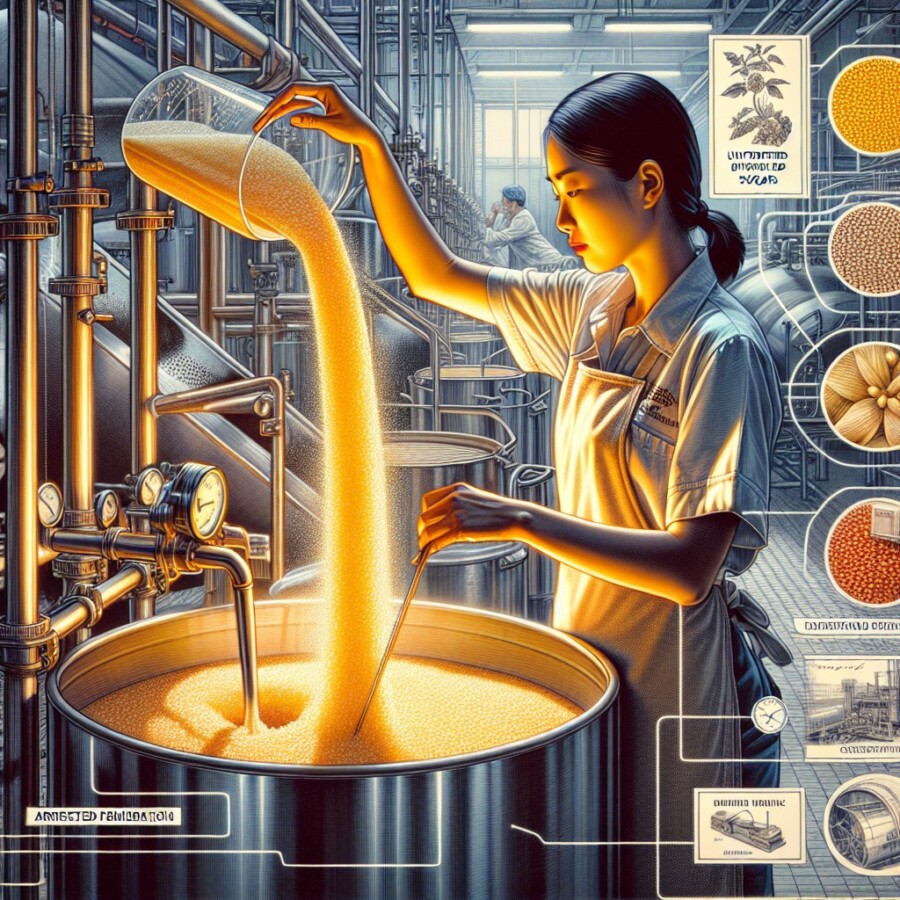The demand for non-alcoholic beer is on the rise, and breweries are working hard to create tasty alternatives to traditional beer. One approach is arrested fermentation, where the yeast is either removed or prevented from becoming active. This can be achieved by adding less malted barley, the main source of sugar that ferments into alcohol. Manipulating unfermented sugars and ingredients, as well as temperatures, is key to achieving the desired flavor. Another method used by some breweries is cryogenic fermentation, where the fermentation process is suddenly halted by exposing the beer to very cold temperatures. This helps retain the flavor while removing the alcohol.
Bigger breweries like Heineken use vacuum distillation, a more expensive process that lowers alcohol’s boiling point and allows the beer to be heated to retain taste while evaporating the alcohol. However, this process results in a lower concentration of flavor compounds. To compensate for this, Heineken adds back the flavors lost during evaporation. They aim to create a non-alcoholic beer that closely resembles the taste and aroma of their traditional beer.
Aroma capture during vacuum distillation is another innovation in the non-alcoholic beer space. This technique allows brewers to capture and reintroduce aromatic compounds into the beer, preserving the distinctive aromas that are integral to the overall sensory experience. Some breweries are also using specialized yeast strains that ferment while producing very little alcohol, enhancing flavor profiles without significant alcohol content.
While many breweries are open about their brewing processes, some keep their techniques secret. The founders of Athletic Brewing Company, for example, have developed a unique process that results in a fully fermented no-alcohol product. They believe their approach is different enough to justify having their own breweries.
As the market for non-alcoholic beer continues to grow, brands may explore fortification to appeal to health-conscious consumers. This could involve adding vitamins, relaxing ingredients, and protein and electrolytes for post-sports recovery. Overall, breweries are combining traditional brewing knowledge with new technologies to meet the demand for tastier non-alcoholic beer.
Original news source: The brewing secrets behind tastier no-alcohol beer (BBC)
🎧 Listen:
Slow
Normal
Fast
📖 Vocabulary:
| 1 | fermentation | The chemical process by which molecules such as glucose are broken down anaerobically |
| 2 | malted | Processed grains that have been soaked, germinated, and dried, used for brewing or distilling |
| 3 | cryogenic | Relating to or involving the use of very low temperatures |
| 4 | distillation | The process of heating a liquid to create vapor, then cooling the vapor to create a liquid |
| 5 | evaporating | The process of turning from liquid into vapor |
| 6 | aroma | A distinctive smell, especially a pleasant one |
| 7 | fortification | The process of strengthening or enriching something |
| 8 | yeast | Microorganisms used in the brewing process, which convert sugars into alcohol |
| 9 | sensory | Relating to or affecting the senses or sensation |
| 10 | electrolytes | Minerals that carry an electric charge when dissolved in body fluids |
| 11 | innovation | The introduction of new methods, ideas, or products |
| 12 | breweries | Places where beer is commercially made |
| 13 | vacuum | A space or container from which air has been completely or partly removed |
| 14 | flavors | Tastes, especially those that are particularly distinctive or sought-after |
| 15 | traditional | Following the long-established customs or beliefs of a group, typically passed down from generation to generation |
Group or Classroom Activities
Warm-up Activities:
– News Summary
Instructions:
1. Divide the class into pairs or small groups.
2. Provide each group with a copy of the article.
3. Instruct the groups to read the article and summarize the main points in a news summary format.
4. After a designated time, have each group present their news summary to the class.
5. Encourage discussion and comparison of the different summaries.
– Word Association
Instructions:
1. Write the word “non-alcoholic beer” on the board.
2. Instruct the students to quickly brainstorm and write down as many words or phrases as they can that are associated with non-alcoholic beer.
3. After a set amount of time, have the students share their lists and create a master list on the board.
4. Discuss the different associations and their significance in relation to the article.
– Opinion Poll
Instructions:
1. Divide the class into pairs or small groups.
2. Assign each group a specific question related to the article, such as “Do you think the demand for non-alcoholic beer will continue to grow?”
3. Instruct the groups to discuss and form an opinion on the question.
4. Have each group conduct a poll within the class, asking each student for their opinion on the assigned question.
5. After gathering the data, have each group present their findings and discuss the overall opinions within the class.
– Pros and Cons
Instructions:
1. Divide the class into pairs or small groups.
2. Assign each group the task of creating a list of pros and cons for the increasing demand for non-alcoholic beer.
3. Instruct the groups to discuss and debate the different points on their lists.
4. After a designated time, have each group present their pros and cons to the class.
5. Encourage discussion and comparison of the different viewpoints.
– Future Predictions
Instructions:
1. Divide the class into pairs or small groups.
2. Instruct each group to brainstorm and discuss their predictions for the future of non-alcoholic beer.
3. Encourage the groups to consider factors such as technology, consumer preferences, and market trends.
4. After a set amount of time, have each group present their predictions to the class.
5. Facilitate a class discussion on the different predictions and the likelihood of each scenario.
🤔 Comprehension Questions:
1. What is one approach breweries use to create non-alcoholic beer?
2. How does cryogenic fermentation work in creating non-alcoholic beer?
3. Why do bigger breweries like Heineken use vacuum distillation?
4. What is the purpose of aroma capture during vacuum distillation?
5. How do some breweries enhance flavor profiles in non-alcoholic beer?
6. Why do some breweries keep their brewing techniques secret?
7. What are some potential fortification options for non-alcoholic beer?
8. How are breweries combining traditional brewing knowledge with new technologies to create tastier non-alcoholic beer?
Go to answers ⇩
🎧✍️ Listen and Fill in the Gaps:
The demand for non-alcoholic beer is on the rise, and breweries are working hard to create tasty alternatives to traditional beer. One approach is arrested fermentation, where the yeast is either removed or prevented from (1)______ active. This can be (2)______ by adding less malted barley, the main source of sugar that ferments into alcohol. Manipulating unfermented sugars and ingredients, as well as (3)______, is key to achieving the desired flavor. Another method used by some breweries is cryogenic fermentation, where the fermentation process is suddenly (4)______ by exposing the beer to very cold temperatures. This helps (5)______ the flavor while removing the (6)______.
Bigger breweries like Heineken use vacuum distillation, a more expensive (7)______ that lowers alcohol’s boiling point and allows the beer to be heated to retain taste while evaporating the alcohol. However, this process results in a lower concentration of flavor (8)______. To compensate for this, Heineken adds back the flavors lost during evaporation. They aim to create a non-alcoholic beer that closely resembles the taste and aroma of their traditional beer.
Aroma capture during vacuum distillation is another innovation in the non-alcoholic beer space. This technique (9)______ brewers to capture and reintroduce aromatic compounds into the beer, preserving the distinctive aromas that are integral to the overall sensory experience. Some breweries are also using (10)______ yeast (11)______ that ferment while producing very little alcohol, enhancing flavor profiles without significant alcohol content.
While many breweries are open about their brewing processes, some keep their techniques (12)______. The founders of Athletic Brewing Company, for example, have developed a unique process that results in a fully fermented no-alcohol product. They believe their approach is (13)______ enough to justify having their own breweries.
As the market for non-alcoholic beer continues to grow, brands may (14)______ fortification to appeal to health-conscious (15)______. This could involve adding (16)______, relaxing ingredients, and protein and electrolytes for post-sports recovery. Overall, breweries are combining traditional brewing knowledge with new technologies to meet the demand for tastier non-alcoholic beer.
Go to answers ⇩
💬 Discussion Questions:
Students can ask a partner these questions, or discuss them as a group.
1. What is your opinion on the rise in demand for non-alcoholic beer?
2. Have you ever tried a non-alcoholic beer? If so, what did you think of it?
3. How would you feel if you found out that your favorite beer brand was using cryogenic fermentation to make their non-alcoholic beer?
4. Do you think it is important for breweries to be transparent about their brewing processes for non-alcoholic beer? Why or why not?
5. What is your favorite beer brand? Would you be interested in trying their non-alcoholic version?
6. How do you think the addition of vitamins and other ingredients to non-alcoholic beer would affect its taste and appeal?
7. Have you ever tried a non-alcoholic beer that was fortified with vitamins or other ingredients? If so, did you notice any difference in taste or effect?
8. Do you think the demand for non-alcoholic beer is primarily driven by health-conscious consumers? Why or why not?
9. What is your opinion on breweries using specialized yeast strains to enhance flavor profiles in non-alcoholic beer?
10. How do you think the taste of non-alcoholic beer compares to traditional beer?
11. How do you think the brewing process for non-alcoholic beer differs from that of traditional beer?
12. Do you think non-alcoholic beer will ever become as popular as traditional beer? Why or why not?
13. How do you think the rise in demand for non-alcoholic beer will impact the brewing industry?
14. Have you ever tried a non-alcoholic beer that closely resembled the taste and aroma of its traditional counterpart? If so, what brand was it and what did you think of it?
15. Would you be interested in trying a non-alcoholic beer that was specifically designed for post-sports recovery? Why or why not?
Individual Activities
📖💭 Vocabulary Meanings:
Match each word to its meaning.
Words:
1. fermentation
2. malted
3. cryogenic
4. distillation
5. evaporating
6. aroma
7. fortification
8. yeast
9. sensory
10. electrolytes
11. innovation
12. breweries
13. vacuum
14. flavors
15. traditional
Meanings:
(A) A space or container from which air has been completely or partly removed
(B) Following the long-established customs or beliefs of a group, typically passed down from generation to generation
(C) Processed grains that have been soaked, germinated, and dried, used for brewing or distilling
(D) The introduction of new methods, ideas, or products
(E) Relating to or affecting the senses or sensation
(F) The process of heating a liquid to create vapor, then cooling the vapor to create a liquid
(G) Tastes, especially those that are particularly distinctive or sought-after
(H) The process of turning from liquid into vapor
(I) Minerals that carry an electric charge when dissolved in body fluids
(J) A distinctive smell, especially a pleasant one
(K) Relating to or involving the use of very low temperatures
(L) The chemical process by which molecules such as glucose are broken down anaerobically
(M) The process of strengthening or enriching something
(N) Microorganisms used in the brewing process, which convert sugars into alcohol
(O) Places where beer is commercially made
Go to answers ⇩
🔡 Multiple Choice Questions:
1. What is one method breweries use to create non-alcoholic beer?
(a) Increased fermentation
(b) Cryogenic distillation
(c) Arrested fermentation
(d) Vacuum distillation
2. What is one way breweries retain flavor in non-alcoholic beer?
(a) Removing all sugars
(b) Cryogenic fermentation
(c) Adding more malted barley
(d) Increasing the fermentation time
3. Which brewery uses vacuum distillation to create non-alcoholic beer?
(a) Athletic Brewing Company
(b) None of the above
(c) All of the above
(d) Heineken
4. What is one innovation in the non-alcoholic beer space?
(a) Aroma capture during vacuum distillation
(b) Adding more alcohol to the beer
(c) Using traditional yeast strains
(d) Keeping brewing techniques secret
5. What is one potential addition to non-alcoholic beer to appeal to health-conscious consumers?
(a) Vitamins
(b) More alcohol
(c) Less flavor
(d) No additives
6. What is one goal of breweries when creating non-alcoholic beer?
(a) To have a higher alcohol content than traditional beer
(b) To use less malted barley
(c) To remove all flavors from the beer
(d) To closely resemble the taste and aroma of traditional beer
7. What is one method breweries use to remove alcohol from beer?
(a) Increased fermentation time
(b) Vacuum distillation
(c) Cryogenic fermentation
(d) Adding more malted barley
8. What is one reason breweries may keep their brewing techniques secret?
(a) They want to increase the alcohol content in their beer
(b) They believe their process is unique and different from others
(c) They don’t want to meet the demand for non-alcoholic beer
(d) They want to use less flavor compounds in their beer
Go to answers ⇩
🕵️ True or False Questions:
1. Some breweries share their non-alcoholic brewing techniques openly.
2. Aroma capture during vacuum distillation does not allow brewers to preserve the distinctive aromas of beer.
3. Breweries are using the same methods, such as arrested fermentation and cryogenic fermentation, to create non-alcoholic beer.
4. Some breweries are using specialized yeast strains that produce very little alcohol to enhance flavor profiles.
5. Vacuum distillation is a more expensive process used by bigger breweries like Heineken to create non-alcoholic beer.
6. Brands may explore fortification of non-alcoholic beer with vitamins, relaxing ingredients, and protein and electrolytes to cater to health-conscious consumers.
7. The demand for non-alcoholic beer is decreasing.
8. Vacuum distillation results in a lower concentration of flavor compounds, so Heineken adds back the lost flavors.
Go to answers ⇩
📝 Write a Summary:
Write a summary of this news article in two sentences.
Check your writing now with the best free AI for English writing!
Writing Questions:
Answer the following questions. Write as much as you can for each answer.
Check your answers with our free English writing assistant!
1. What are some methods that breweries use to create non-alcoholic beer?
2. How does cryogenic fermentation help retain flavor while removing alcohol?
3. What is the process of vacuum distillation and how does it affect the flavor of non-alcoholic beer?
4. How do some breweries capture and reintroduce aromatic compounds into their non-alcoholic beer?
5. What are some potential ways that breweries may fortify non-alcoholic beer in the future?
✅ Answers
🤔✅ Comprehension Question Answers:
1. One approach breweries use to create non-alcoholic beer is arrested fermentation, where the yeast is either removed or prevented from becoming active.
2. Cryogenic fermentation works in creating non-alcoholic beer by suddenly halting the fermentation process through exposure to very cold temperatures. This helps retain the flavor while removing the alcohol.
3. Bigger breweries like Heineken use vacuum distillation because it is a more expensive process that lowers alcohol’s boiling point and allows the beer to be heated to retain taste while evaporating the alcohol.
4. The purpose of aroma capture during vacuum distillation is to allow brewers to capture and reintroduce aromatic compounds into the beer, preserving the distinctive aromas that are integral to the overall sensory experience.
5. Some breweries enhance flavor profiles in non-alcoholic beer by using specialized yeast strains that ferment while producing very little alcohol, enhancing flavor profiles without significant alcohol content.
6. Some breweries keep their brewing techniques secret because they believe their approach is unique enough to justify having their own breweries.
7. Some potential fortification options for non-alcoholic beer include adding vitamins, relaxing ingredients, and protein and electrolytes for post-sports recovery.
8. Breweries are combining traditional brewing knowledge with new technologies to create tastier non-alcoholic beer by manipulating unfermented sugars and ingredients, as well as temperatures, to achieve the desired flavor. They are also using techniques like cryogenic fermentation, vacuum distillation, and aroma capture to retain taste and aroma while removing alcohol.
Go back to questions ⇧
🎧✍️✅ Listen and Fill in the Gaps Answers:
(1) becoming
(2) achieved
(3) temperatures
(4) halted
(5) retain
(6) alcohol
(7) process
(8) compounds
(9) allows
(10) specialized
(11) strains
(12) secret
(13) different
(14) explore
(15) consumers
(16) vitamins
Go back to questions ⇧
📖💭✅ Vocabulary Meanings Answers:
1. fermentation
Answer: (L) The chemical process by which molecules such as glucose are broken down anaerobically
2. malted
Answer: (C) Processed grains that have been soaked, germinated, and dried, used for brewing or distilling
3. cryogenic
Answer: (K) Relating to or involving the use of very low temperatures
4. distillation
Answer: (F) The process of heating a liquid to create vapor, then cooling the vapor to create a liquid
5. evaporating
Answer: (H) The process of turning from liquid into vapor
6. aroma
Answer: (J) A distinctive smell, especially a pleasant one
7. fortification
Answer: (M) The process of strengthening or enriching something
8. yeast
Answer: (N) Microorganisms used in the brewing process, which convert sugars into alcohol
9. sensory
Answer: (E) Relating to or affecting the senses or sensation
10. electrolytes
Answer: (I) Minerals that carry an electric charge when dissolved in body fluids
11. innovation
Answer: (D) The introduction of new methods, ideas, or products
12. breweries
Answer: (O) Places where beer is commercially made
13. vacuum
Answer: (A) A space or container from which air has been completely or partly removed
14. flavors
Answer: (G) Tastes, especially those that are particularly distinctive or sought-after
15. traditional
Answer: (B) Following the long-established customs or beliefs of a group, typically passed down from generation to generation
Go back to questions ⇧
🔡✅ Multiple Choice Answers:
1. What is one method breweries use to create non-alcoholic beer?
Answer: (c) Arrested fermentation
2. What is one way breweries retain flavor in non-alcoholic beer?
Answer: (b) Cryogenic fermentation
3. Which brewery uses vacuum distillation to create non-alcoholic beer?
Answer: (d) Heineken
4. What is one innovation in the non-alcoholic beer space?
Answer: (a) Aroma capture during vacuum distillation
5. What is one potential addition to non-alcoholic beer to appeal to health-conscious consumers?
Answer: (a) Vitamins
6. What is one goal of breweries when creating non-alcoholic beer?
Answer: (d) To closely resemble the taste and aroma of traditional beer
7. What is one method breweries use to remove alcohol from beer?
Answer: (c) Cryogenic fermentation
8. What is one reason breweries may keep their brewing techniques secret?
Answer: (b) They believe their process is unique and different from others
Go back to questions ⇧
🕵️✅ True or False Answers:
1. Some breweries share their non-alcoholic brewing techniques openly. (Answer: False)
2. Aroma capture during vacuum distillation does not allow brewers to preserve the distinctive aromas of beer. (Answer: False)
3. Breweries are using the same methods, such as arrested fermentation and cryogenic fermentation, to create non-alcoholic beer. (Answer: False)
4. Some breweries are using specialized yeast strains that produce very little alcohol to enhance flavor profiles. (Answer: True)
5. Vacuum distillation is a more expensive process used by bigger breweries like Heineken to create non-alcoholic beer. (Answer: True)
6. Brands may explore fortification of non-alcoholic beer with vitamins, relaxing ingredients, and protein and electrolytes to cater to health-conscious consumers. (Answer: True)
7. The demand for non-alcoholic beer is decreasing. (Answer: False)
8. Vacuum distillation results in a lower concentration of flavor compounds, so Heineken adds back the lost flavors. (Answer: True)
Go back to questions ⇧













